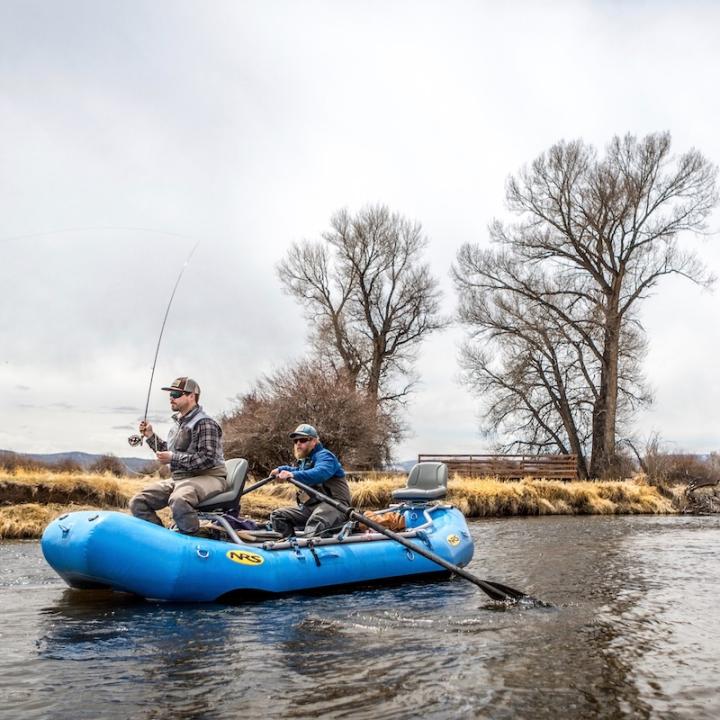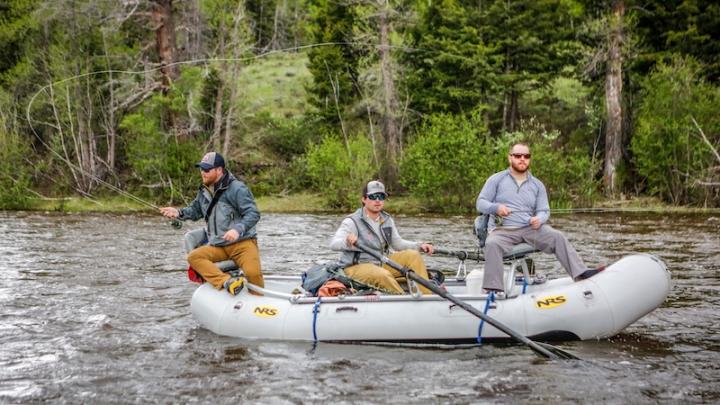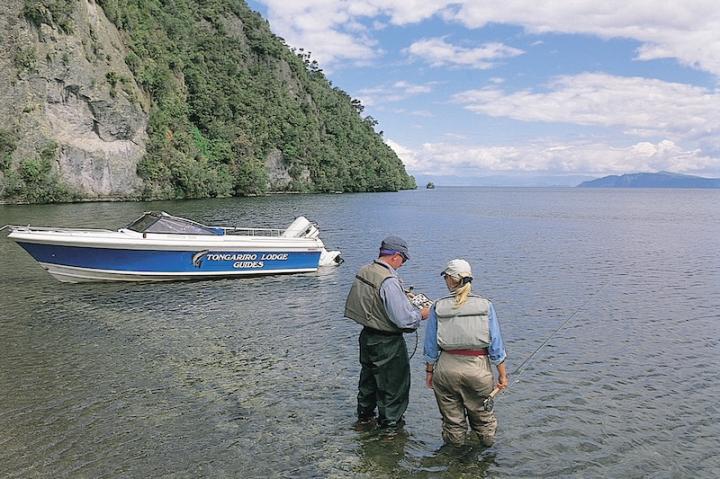Would you like to spend time on your fly fishing vacation casting a fly from a raft or drift boat, or heading out on a float trip? Whether you're a seasoned pro or just trying for the first time, here are five important rules to remember when fly fishing from a raft or drift boat.
Casting, managing line and landing fish is completely different from a moving watercraft.
A fly fishing float trip, indeed, any fly fishing from a boat comes with some serious advantages along with some technical difficulties that are all often easily overcome by following the rules explained here.
"I spent a decade rowing clients and now fish from a boat a few times a week throughout the seasons," says our fly fishing expert and seasoned guide, Zach Lazzari.
"Fly fishing float trips and fishing from a boat are great ways to access more water and reach places where wading is simply too difficult. However, it does require teamwork in many cases, but with the right experience and following these important rules, you can make the most of solo missions as well."

Rule #1 of fishing from a boat: Safety first!
Before we even jump into the fishing, safety needs at the forefront of your mind.
Life vests
I know, I know, you hear about it all the time, but when I watch anglers drifting past without life jackets, PDFs (personal floatation devices) or even a clue to the dangers of fly fishing without, it makes me cringe a bit.
There will be situations on your fly fishing trip where you can fish comfortably without a PFD, but there are more times you'll need to wear one.
Personally, I like the fishing-specific models because they offer pockets for essential gear throughout the day. They also have a comfortable, lower profile.
As a general rule, if you don’t know the waters around your fishing lodge or ranch extremely well, wear a PFD.
For example, did you know that the Bitterroot River is the deadliest in Montana? It’s a low-gradient, slow moving river that doesn’t feel dangerous at all...
Remember: If you don’t know the water, wear a PFD.
Water temperature
The other dangerous element is water temperature. More people die from exposure and cold shock than from actual drowning.
Know the conditions of your fly fishing lodge's waters and wear insulating clothing to help if necessary. I find that waders combined with a snug PFD will shield you from cold shock for a short while. Make sure to wear a wading belt, too.
Still not sure what to pack for your fly fishing vacation? We've got you covered with our essential fishing gear guide.
Keep watch
In addition to being an angler, you should also act as an extra set of eyes and ears for the oarsmen.
Even the most experienced guides can use a helping hand, especially if there was a recent storm or high water situation that may have created new hazards in the river.
Don’t be afraid to point out potential dangers and communicate safety concerns with the rower.
Rule #2: Split the boat
Now that we have the safety speech out of the way, it’s time to address the boat positions. (If you are fishing solo on your fly fishing trip, you can ignore this section as you can cast anywhere).
When two anglers are fishing however, respecting space is important and it will prevent tangles.

As a general rule, the oarlocks are a guideline for splitting the fishing boat. The front angler should fish ahead of the boat and recast when flies reach that line. The back angler can cast ahead, starting a drift at the oarlocks and finishing below the boat.
In terms of casting, the angles can still present an issue. To prevent crossing lines, alternate casts. Pay attention to your drift and try to stagger the timing with the rear angler so you can alternate casts without having to wait. It makes a huge difference by removing the inconvenient tangles throughout the day!
Rule #3: Use your front or back advantage
Many anglers believe that when fly fishing from a boat, the front position has an advantage because the angler gets first looks.

"In my experience," says Zach, "it’s a pretty even split and some days, the rear angler picks up more fish."
The key to success on your fly fishing float trip is capitalizing on the advantages of each position.
- Front angler advantages: The biggest advantage in the front set is first looks and lower spooking potential. You can cast ahead of the boat and present your fly before the boat itself comes within sight of the fish. This is excellent on flat water and when the boat is casting shadows. Get ahead and fish ahead as much as possible from the front. It’s also a great position for dead drifts with dry flies or indicators.
- Back angler advantages: While the front angler is getting ahead and taking advantage of first looks, the rear anglers can add more natural movement to flies. Quartering casts off the back of the boat offers an incredible angle for retrieving streamers. That angle also adds a little extra movement on dry flies and nymphs. While you might associate this with drag, I’ve seen it create unintentional twitches and skates that are deadly in the summer months. Use your angles to move flies more and you just might catch more fish.
Rule #4: Clear your line
Line management is critical in any fly fishing environment, but especially so in boats. Packs, gear, raft frames and just about anything else will snag line, interrupting casts and potentially losing fish.
Take stock of your area before fishing and remove any obstacles. While you are fishing, pay attention to snags as well. If your line hangs up on anything regularly, don’t fight it, fix it.
Rule #5: Pull over and wade
We have a habit of wanting to fish out of the boat the entire trip. After all, it’s a ton of fun and why bother wading when you have a boat doing the hard work!
The boat offers plenty of advantages but it’s a good move to pull over and fish the sweet spots a little harder.

Sometimes it takes more than a single drift to move a fish and there are a ton of prime runs that are skirted by boat anglers. It’s especially difficult to fish the inside corner of a run from a moving boat and I love stopping to hit these spots a little harder.
Are you ready to hit the river on a raft or boat?
It doesn’t matter if you are fishing in Montana, heading out on a fly fishing vacation to Chile, casting a line on an angling trip to Alaska, or visiting a fly fishing lodge in North Carolina or New Zealand – it’s hard to go wrong from the bow or stern of a fishing raft or drift boat. Follow these safety guidelines for fishing from a boat: fish hard and enjoy the ride!
After a few days on the boat, you will find a rhythm, and find that it’s one of the best ways to explore and enjoy the fantastic sport of fly fishing!
We also have some stunning fly fishing lodges in Wyoming, a fabulous fishing lodge in Idaho and a luxury Colorado lodge just waiting to be explored.
So what are you waiting for?
Book your fly fishing vacation today!
Original article written by freelance writer and fishing aficionado, Zach Lazzari.
Co-written, edited and created by Kate Hammaren; luxury and adventure travel writer, editor and world traveler.
About our author, Zach Lazzari
Zach Lazzari is a freelance outdoor writer, fly fisherman and full-time adventure traveler. After a decade of guiding anglers in Colorado, Montana, Alaska and Patagonia, he turned to the travel and media industry to continue pursuing new species in exciting locations. Zach has written for The Drake, Orvis, NRS, and many other brands and publications in the outdoor industry.